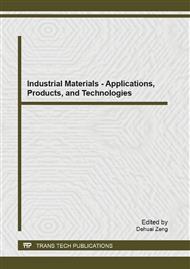[1]
Alting L., Kimura F., Hansen H. N. and Bissacco G., (2003), Micro Engineering, Annals of the CIRP, 52(2), 635-657.
DOI: 10.1016/s0007-8506(07)60208-x
Google Scholar
[2]
Ehmann K. F., Bourell D., Culpepper M. L., Hodgson T. J., Kurfess T. R., Madou M., Rajurkar K. and Devor R. E., (2005).
DOI: 10.21236/ada466761
Google Scholar
[3]
World Technology Evaluation Center (WTEC), Inc. Baltimore, Maryland.
Google Scholar
[4]
Slocum A. H., (1992), Precision machine design, Prentice Hall, Englewood Hill, Michigan, USA. Fujita H., (1998), Microactuators and micromachines, Proceedings of IEEE, 86(8), 1721-1732.
Google Scholar
[5]
Mekid S., (2005), Design Strategy for Precision Engineering: Second Order Phenomena, Engineering Design, 16(1).
DOI: 10.1080/09544820512331327740
Google Scholar
[6]
Trimmer W. S. N. T., (1997), Micromechanics and MEMS, Classic and Seminal papers to 1990, IEEE, New York.
Google Scholar
[7]
Trimmer W. S. N., (1989), Microrobots and micromechanical systems, Sensors and Actuators, 19, 267-287.
DOI: 10.1016/0250-6874(89)87079-9
Google Scholar
[8]
Ishihara H., Arai F. and Fukuda T., (1996), Micro mechatronics and micro actuators, IEEE/ASME Transaction of Mechatronics, 1, 68-79.
DOI: 10.1109/3516.491411
Google Scholar
[9]
Fujita H., (1998), Microactuators and micromachines, Proceedings of IEEE, 86(8), 1721-1732.
Google Scholar
[10]
Kussul E., Baidyk T., Ruiz-Huerta L., Caballero-Ruiz A. and Velasco G., (2006), Scaling down of microequipment parameters, Precision Engineering, 30, 211-222.
DOI: 10.1016/j.precisioneng.2005.08.001
Google Scholar
[11]
Mekid S., Gordon A. and Nicholson P., (2004), Challenges and rationale in the design of miniaturised machine tool, International MATADOR Conference, UMIST, Manchester, 465-471.
DOI: 10.1007/978-1-4471-0647-0_69
Google Scholar
[12]
Trimmer W. S. N. and Gabriel K. J., (1987), Design considerations for a practical electrostatic micromotor, Sensors Actuators, 11, 189-205.
DOI: 10.1016/0250-6874(87)80016-1
Google Scholar
[13]
Li, Peiyuan, micromilling of hardened steel, thesis, 2009, TU Delft University.
Google Scholar
[14]
Lu Z. and Yoneyama T., (1999), Micro cutting in the micro lathe turning system, International Jounal of Machine Tools & Manufacture, 39(7), 1171-1183.
DOI: 10.1016/s0890-6955(98)00092-3
Google Scholar
[15]
Mekid, S., High Speed Desktop Ultra Precision CNC Micro/MesoMachine, World Congress on Industrial Materials Applications, Products and Technologies, Beijing, (2013).
DOI: 10.4028/www.scientific.net/amr.739.640
Google Scholar


